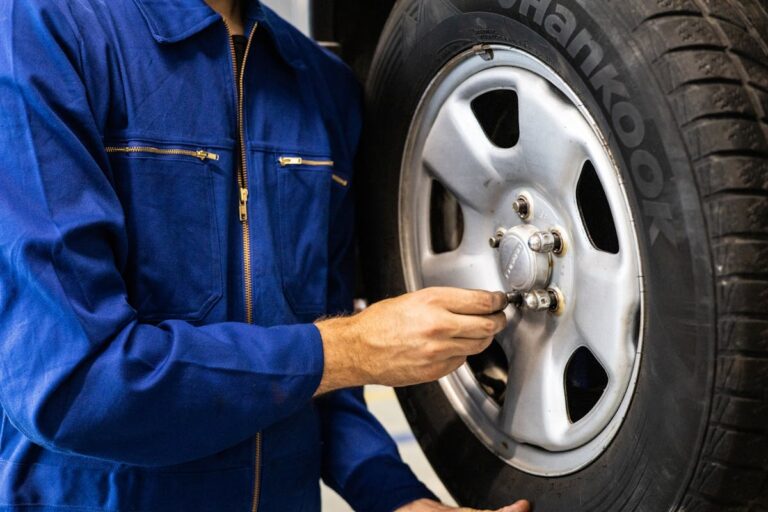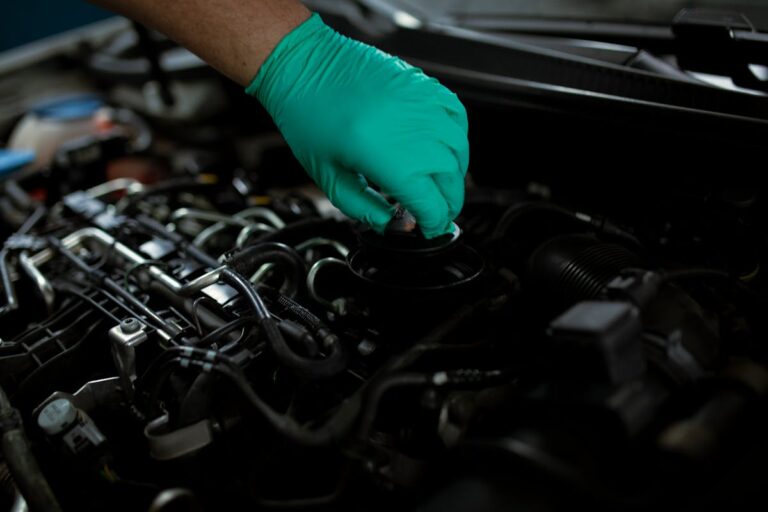In the domain of vehicle maintenance, the significance of wheel alignment and tire balancing often goes unnoticed. Both these aspects play a pivotal role in ensuring smooth and safe driving conditions, as well as extending the longevity of the tires. However, the intricate mechanisms behind these processes, the signs of misalignment or imbalance, and their effects on vehicle performance and safety are not commonly understood. In the following discussion, we will explore deeper into these elements, shedding light on why regular wheel alignment checks and tire balancing should be a priority in vehicle maintenance.
Understanding Wheel Alignments
When it comes to maintaining your vehicle, understanding wheel alignments is a critical aspect. This procedure, often overlooked, is integral to the preservation of your car’s health and your safety on the road. It encompasses the adjustment of the angles of your vehicle’s wheels to meet specific manufacturer specifications.
Various alignment techniques exist, each depending on the type of vehicle and the specific alignment needs. The most common are toe, camber, and caster alignments. Toe alignment affects the direction of the tires compared to the centerline of the vehicle. Camber alignment involves adjusting the tilt of the wheels from the top to bottom, while caster alignment pertains to the angle of the steering pivot.
The alignment benefits are numerous. Proper alignment improves vehicle handling, guarantees even tire wear, increases fuel efficiency, and enhances driving safety. Incorrect alignment can lead to premature tire wear, poor handling, and increased fuel consumption. Consequently, regular alignment checks, ideally every two to three years or after a significant impact, such as hitting a pothole, are highly recommended. By understanding these facets of wheel alignment, you can maintain your vehicle’s performance and longevity.
Importance of Proper Tire Balancing
Just as wheel alignments are crucial for vehicle maintenance, tire balancing is another essential factor for ideal car performance and safety. When tires aren’t balanced correctly, it can lead to uneven wear and tear, which greatly reduces tire longevity. To guarantee your tires last as long as they should, regular tire balancing is a must.
Tire balancing is the process of equalizing the weight of the combined tire and wheel assembly so that it spins smoothly at high speed. Balancing involves putting the wheel/tire assembly on a balancer, which centers the wheel and spins it to determine where the weights should go.
Proper tire balancing offers a myriad of benefits. It provides a smooth and comfortable ride, delivering excellent ride comfort for the driver and passengers. It also helps to minimize the bouncing, road noise, and vibration that you might experience when driving. Additionally, by reducing tire bounce and tread wear, tire balancing can help to improve your vehicle’s fuel economy.
In essence, proper tire balancing is an indispensable part of vehicle maintenance. It is a simple but profound way to maximize tire longevity, enhance ride comfort, and guarantee superior vehicle performance.
Signs Your Wheels Need Alignment
Identifying the need for wheel alignment can often be deduced from specific symptoms exhibited by your vehicle. These may include unusual steering behavior, such as the car pulling to one side, accelerated wear on tire treads indicating uneven contact with the road, and the experience of vibrations in the steering wheel. Thoroughly examining these symptoms in the upcoming discussion will provide a thorough understanding of when wheel alignments are necessary.
Detecting Unusual Steering Behavior
As a driver, you might have experienced your vehicle pulling to one side or the other while driving straight ahead. This phenomenon, known as steering pull, is one of the most common indicators of misaligned wheels. It’s a clear sign that the vehicle’s alignment is off and needs to be corrected. Steering pull is not a minor inconvenience; it can notably impact your vehicle’s fuel efficiency, tire wear, and overall performance.
Another unusual steering behavior to watch out for is steering wobble. This typically manifests as an oscillation or shimmying sensation in the steering wheel while driving at certain speeds. Steering wobble is often caused by an imbalance in the vehicle’s tires or wheels. It can lead to excessive tire wear, decreased fuel efficiency, and increased strain on the vehicle’s suspension system.
Detecting these unusual steering behaviors early is vital. They not only affect your driving experience but can also lead to more serious issues if left unchecked. Regular wheel alignments and tire balancing are key preventative measures, ensuring your vehicle operates at its optimum level and reducing the risk of costly future repairs. Always consult with a professional if you notice any unusual steering behaviors in your vehicle.

Worn Out Tire Indicators
Three significant indicators signal that your wheels might be in need of alignment, all related to tire wear patterns. These patterns are evident in the state of the tire tread, which can provide valuable insights into the health of your car’s alignment.
The first sign of improper alignment is uneven wear. This can be found on one side of the tire tread, indicating that the corresponding wheel is misaligned. An uneven wear pattern is usually the result of camber misalignment, a condition where the wheel leans too much to the inside or outside.
The second indicator is rapid wear, particularly on the edges of the tire tread. This is a symptom of toe misalignment, where the front of the tires are pointed inwards or outwards rather than straight ahead. The misalignment increases friction while driving, leading to faster wear and tear.
The third and final indicator is feathering, a condition where the tire tread displays a series of high and low spots. This wear pattern can be felt as well as seen, and it typically indicates a combination of camber and toe misalignment.
Recognizing these signs is essential to maintaining your vehicle’s safety and performance. Regularly inspect your tires for these wear patterns to confirm proper alignment.
Handling Vibrations While Driving
On the road, one of the most distinct signs that your wheels might require alignment is the presence of vibrations in your vehicle while driving. These vibrations can greatly reduce your driving comfort and indicate that your wheels are misaligned. While wheel imbalance is a common cause for such vibrations, other issues like damaged tires or suspension components can also contribute to this problem.
Understanding the probable vibration causes will aid you in identifying the need for wheel alignment. The vibration symptoms indicating misalignment can include:
- Steering wheel vibration: The steering wheel of your vehicle starts to vibrate noticeably while driving.
- Vehicle shaking: The entire vehicle or a part of it shakes, especially at higher speeds.
- Uneven tire wear: One side of your tires wears down faster than the other, indicating a possible misalignment.
- Pulling to one side: The vehicle pulls to one side while driving, even when you are not turning the steering wheel.
Indicators of Tire Imbalance
Spotting the signs of tire imbalance can be a tricky task, but it’s essential for maintaining the perfect performance of your vehicle. The most common indication of imbalance is unusual tire wear. An even tire wear pattern is crucial for peak tire performance, and any irregularities can be a clear sign of imbalance. You may notice that tires wear down more on one side than the other, or see patchy wear in spots. This uneven wear is typically due to alignment issues which can often be traced back to a tire imbalance.
Another key indicator of tire imbalance is vibrations while driving, particularly at high speeds. These vibrations may be felt in the steering wheel or throughout the vehicle, and are usually more noticeable on smooth roads. The vibrations are a result of the tires not rotating evenly, causing the vehicle to shake or jitter.
Finally, if your vehicle pulls to one side while driving, it may suggest an imbalance. This pulling effect is often due to uneven tire wear and alignment issues. It’s important to identify and rectify tire imbalance as early as possible to prevent further damage and promote safe and efficient vehicle operation.
Impact on Vehicle Performance
While it may not be immediately evident, the performance of a vehicle can be greatly impacted by tire imbalance and misalignment. Neglecting these aspects of vehicle maintenance can lead to significant degradation in performance metrics, negatively impacting driving comfort and fuel efficiency.
These implications for vehicle performance include:
- Fuel Efficiency: Improper alignment and balance increase tire rolling resistance, which means your vehicle has to work harder and consume more fuel to maintain the same speed.
- Tire Wear: Misalignment and imbalance can cause your tires to wear unevenly and prematurely, requiring more frequent replacements.
- Vehicle Handling: Poor alignment and balance can compromise your car’s handling ability, making it more difficult to steer, especially at high speeds.
- Driving Comfort: Misalignment and imbalance can lead to vibrations that make your ride less smooth and comfortable.
Safety Concerns and Risks
The safety implications of improper wheel alignment and tire balancing should not be underestimated. Misalignment and imbalance can lead to increased tire wear, reducing their lifespan and potentially leading to sudden failures. Moreover, these issues can compromise vehicle control, increasing the risk of road accidents.
Preventing Road Accidents
Having properly aligned wheels and balanced tires is essential in preventing road accidents, a substantial safety concern. Properly aligned wheels guarantee ideal contact of the tires with the road surface, providing accurate steering, enhancing road safety, and contributing to accident prevention. Similarly, balanced tires minimize vibrations and irregular wear, which can lead to sudden tire failure, a common cause of road accidents.
To enhance road safety, consider the following:
- Regularly inspect tires for uneven wear patterns. This can indicate misalignment and lead to dangerous blowouts if not addressed promptly.
- Perform tire balancing every time you rotate your tires or replace them. Unbalanced tires can cause vibrations, premature tire wear, and potentially, loss of control.
- Wheel alignment should be checked every 10,000 miles or at least once a year. Misaligned wheels can cause the vehicle to pull to one side, leading to unexpected lane deviations.
- Maintain recommended tire pressure. Under-inflated tires can overheat, causing blowouts, while over-inflated tires can decrease traction, increasing the risk of accidents.
Adhering to these guidelines not only enhances vehicle performance but also greatly contributes to road safety and accident prevention.
Mitigating Tire Damage
To keep your vehicle running smoothly and safely, one should focus on mitigating tire damage, an often overlooked aspect of automobile maintenance. The longevity of a tire’s lifespan is greatly influenced by how it is treated. As a result, proper alignment and tire balancing are vital strategies in preventing unnecessary damage and ensuring maximum tire lifespan.
Tire alignment benefits include reduced tire wear, improved fuel efficiency, and enhanced driving safety. Poor alignment can lead to uneven tire wear, which shortens the lifespan of your tires and potentially causing accidents due to increased instability. Regular alignment checks and adjustments can prevent such issues, increasing the overall lifespan of the tires.
Balancing your tires is equally essential to mitigate tire damage. An unbalanced tire could lead to uneven wear, vibrations, and strain on the vehicle’s suspension system. Regular tire balancing can prevent these issues, leading to a smoother ride, improved tire lifespan, and decreased wear on vehicle components.
Preventative Maintenance Tips
Proactive vigilance in vehicle care can greatly extend the lifetime of your car’s tires and improve overall performance. Adhering to a maintenance schedule and performing preventative inspections are key actions in this process.
Here are four tips that can help you in your preventative maintenance efforts:
- Adhere to a Maintenance Schedule: Car manufacturers provide recommended maintenance schedules for a reason. They know the ideal timing for inspections and replacements. Following these schedules can help avert unnecessary wear and tear on your tires.
- Perform Regular Preventative Inspections: Regularly inspect your tires for uneven wear patterns, cuts, or punctures. This can help you identify and address issues before they escalate.
- Rotate Your Tires Regularly: Tire rotation helps guarantee even wear, extending the lifespan of your tires. The recommended rotation schedule can usually be found in your vehicle’s owner’s manual.
- Maintain Proper Tire Pressure: Regularly check your tire pressure and adjust as needed. Over or under-inflated tires can lead to premature wear, poor vehicle handling, and decreased fuel efficiency.
Frequently Asked Questions
How Often Should I Get My Wheels Aligned and Tires Balanced?
Alignment frequency should ideally be every two to three years, while balancing intervals are recommended every 5,000 to 6,000 miles. However, these can vary depending on driving conditions and vehicle performance needs.
Is Wheel Alignment and Tire Balancing Covered Under Warranty?
Warranty coverage for wheel alignment and tire balancing typically depends on the specific vehicle’s warranty terms. These services are often considered regular maintenance, hence exceptions may apply, excluding them from standard warranty coverage.
Can I Perform Wheel Alignment and Tire Balancing at Home?
While DIY techniques exist, performing wheel alignment and tire balancing at home requires specialized equipment and expertise. Incorrect execution can lead to safety issues, consequently professional services are highly recommended.
What Is the Cost of Wheel Alignment and Tire Balancing Services?
The cost of wheel alignment and tire balancing services varies considerably, depending on location and service provider. Factors influencing cost include vehicle make and model, labor rates, and the specific alignment and balancing procedures employed.
Does Weather Affect the Alignment and Balance of My Tires?
Yes, weather impacts can cause alignment changes and imbalance in your tires. Extreme temperatures and conditions like snow, ice, or potholes can alter the tire pressure, leading to misalignment and imbalance issues over time.





